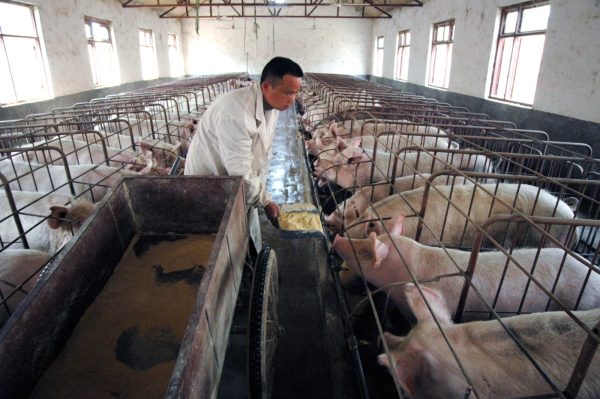China’s Main Food Security Challenge: Feeding Its Pigs

Amid the worsening global food crisis, there are mounting domestic and international concerns regarding food security in China, the world’s most populous country and largest food importer. The Chinese government has pointed to its bumper grain harvests and massive grain reserve systems to reassure its public and international audiences that the country will not face imminent grain security risks. At present, China holds significant quantities of the world’s grain reserves. According to a report in the Nikkei Asia, by mid-2022, China is expected to hold 69 percent of the world’s maize (corn) reserves, 60 percent of its rice, 51 percent of the world’s wheat, and 37 percent of its soybeans. However, this was denied by the country’s foreign ministry.
Nonetheless, as an official from the country’s National Food and Strategic Reserves Administration noted in November 2021, supply in the domestic grain market is “fully guaranteed” while grain reserves are at a “historical high level.”
Given that China’s rice and wheat imports only represent a smaller proportion of its overall consumption and with the world’s largest rice and wheat reserves, China does not seem to have major problems in the near-term regarding staple supplies. Nevertheless, the most significant risk to China’s food security lies in its pig supplies. Questions over how to feed China’s hog herd remain a growing challenge for Beijing and a threat to global food security.
China’s Soybean Shortage
–
Weekly Newsletter
N
Across the Asia-Pacific
Get the Newsletter
Alongside China’s phenomenal economic growth since the “Reform and Opening up” period, food preferences, diets, and lifestyles also began to change, resulting in a rapidly rising demand for edible oils and meat. Since the early 1980s, China’s massive appetite for pork has resulted in the industrialization of pig farming and a multi-billion-dollar feed industry. Today, the feed sector in China comprises 42 percent pig feed, 43 percent poultry feed, and 9 percent fish feed. China’s enormous appetite for feed is driven largely by its rapidly growing hog herd. As approximately 75 percent of animal feed is soybean meal, soybeans are critical.
Enjoying this article? Click here to subscribe for full access. Just $5 a month.
Although China is the world’s biggest soybean importer today, this was not always the case; in fact, China used to be a major exporter. In order to qualify for accession to the World Trade Organization (WTO), however, China had to make considerable compromises, including reducing overall agricultural tariffs and support for domestic agriculture. Meanwhile, Lester Brown’s 1994 article and 1995 book, “Who Will Feed China?” raised global concerns regarding China’s ability to feed itself. Beijing then made a strategic decision to abandon soybean cultivation and focus on self-sufficiency in staple grain to ensure calorie supply. As a result, the soybean import quota was removed, and the tariff rate was dropped to 3 percent.
Since the mid-1990s, with the booming feed sector and declining domestic production, China’s soybean imports have increased significantly: from 1 million metric tonnes (mmt) in 1996 to 95 mmt in 2017. China is the largest importer of soybeans in the world, buying over 60 percent of the world’s total exports. From 2000-01 to 2016-17, China’s imports accounted for 88 percent of the growth in the world’s soybean trade. U.S. and Brazilian soybean producers have two advantages over China in domestic soybean production: cheaper and genetically modified (GM) strains.
As imports grew, China reduced its domestic production. From 2008 to 2013, the area dedicated to soybean production shrank by 24 percent. In Heilongjiang province, the traditional center of Chinese production, land area used for soybean cultivation dropped by 42 percent. The imported soybeans are genetically modified and are mainly processed to produce cooking oil and the meal used in animal feed. Locally produced soybeans are non-GM and primarily used for direct human consumption (in tofu, soymilk, and soy sauce, for example). Consumption of soybean food products has grown, but consumption of edible oils and soybean meal has grown faster and will continue to increase due to rising consumer incomes and changing dietary preferences.
China’s Growing Feed Corn Problem
Over the past decades, as China moves to modernize its pig sector, replacing backyard pig farming with modern and commercial large-scale pig production, there has been a rapid surge in the domestic demand for feed corn. Compared to wheat, soy, and rice, the domestic corn shortage is of even greater concern to Chinese policymakers, at least in the near future. Over the past few years, China’s corn imports have increased by several fold due to deficits in production. In 2021, China had to import 28.35 million metric tons of corn, up 152 percent from the previous record of 11.3 million tons in 2020. Most corn imports came from the United States, Argentina, Brazil, and Ukraine.
Although the decrease in U.S. corn imports in recent years can be attributed to the China-U.S. trade war, China had sought out other corn suppliers, importing a considerable amount of corn from Ukraine. Since 2020, China has been Ukraine’s top trading partner, viewing the country as a critical entrepôt for BRI-related commerce, with its agricultural exports becoming increasingly crucial for China. Combined with potential labor shortages and rising gas and fertilizer prices, the Russia-Ukraine war and subsequent disruptions to shipments to China will create significant inflationary pressure.
Due to uncertainty and lingering tensions between China and the United States as well as the Ukraine-Russia conflict, further diversification of corn imports from Romania and other European countries remains important alternatives.
China’s Efforts to Manage Its Pig Risks
In recent years, the Chinese government has sought to boost domestic soybean and corn production. For instance, in January 2022 the Ministry of Agriculture and Rural Affairs announced China’s new 14th Five-Year Plan on crop farming. Under this, China will aim to significantly increase domestic soybean and corn output to boost self-sufficiency in supply of the feed grains. In particular, by the end of 2025, China wants to have produced approximately 23 million tons of soybeans, up 40 percent from current output levels.
Over the past few years, rising trade tensions between China and the United States have affected the bilateral soybean trade. Within a framework of food security, China has sought replacements for soybean meal and other products produced from soybean. As China’s reliance on U.S. soybeans was viewed as a weak link during the trade war under the previous U.S. administration, Beijing has sought to encourage soybean production elsewhere, particularly Russia. In 2018, China’s soybean imports from Russia reached 0.8 mmt, up 64 percent compared to 2017. Given Russia’s huge potential to produce soybeans, China has exported more agricultural labor to Russia and increased investment in Russian soybeans. In 2021, however, Russia imposed a 30 percent tariff on soybean exports in response to increasing food prices.
Enjoying this article? Click here to subscribe for full access. Just $5 a month.
Further seeking to increase domestic soybean production, the Chinese government has announced plans to support greater use of technology to stabilize crop yield and ensure supplies. Although Beijing has long withheld permissions for domestic cultivation of GM crops due to public opposition to GM food, recent moves from the Chinese government suggest that approval for the commercial planting of GM corn and soybeans will be given soon. The standards for approving GM corn and soybean varieties were released in early June. This follows announcements from China’s top policymakers, who have urged progress in biotech breeding, as well as from the Ministry of Agriculture and Rural Affairs, which suggest that China is preparing to allow greater use of GM technology in agriculture, with Beijing keen to support domestic biotech companies. For instance, in December 2021, the Ministry of Agriculture and Rural Affairs announced plans to approve the safety of more GM corn varieties produced by domestic companies followed by the approval of two new GM corn varieties for import in January 2022.
To reduce dependence on foreign feed grains, China, in recent years, has also sought to directly import more pork and other meat products. For instance, the country’s overall meat and fishery imports almost doubled in value between 2017 and 2019, though this was also largely driven by a shortage in domestic pork. In 2020, China imported a record 4.4 million tons of pork, which accounted for more than 40 percent of global trade. China is now also the largest beef importer in the world. In 2020, the country imported 2.1 million tons of beef, 23 percent of its beef requirement and 30 percent of global trade. Even for fisheries, China, a country which has long been the largest exporter of fish, has been importing more and more. In 2016, China imported 4 mmt of fishery products, and in 2019, it jumped to 6.3 mmt.
Additionally, China is undertaking efforts to reduce domestic pork consumption. With much concerning regarding the negative health impacts of the population’s high consumption of pork, the Chinese government has been advising the population to eat more poultry and fish, and less pork, which would also reduce the country’s dependence on imports. In 2018, with the outbreak of African swine fever, pork prices increased significantly. To ensure the country’s meat supply, the Chinese government introduced policies to increase domestic poultry production, leading to a shift in the country’s feed structure: a steep decline in pig feed and an increase in poultry feed. For instance, in Shandong province, China’s biggest feed producer, pig feed declined by 28 percent, and poultry feed grew by 8.6 percent, between January and April 2019. As the feed conversion ratio is 2.7 to 5.0 for pigs but only 1.7 to 2.0 for chickens, this lowered China’s total feed demand without reducing meat output.
Conclusion
As China’s grain imports, particularly corn and soybeans, have skyrocketed to unprecedented levels, the country’s vulnerability to trade tensions and supply shocks has increased. Even though China has relatively less exposure to global food trade in terms of staple supplies, there remains substantial risks in feed grains. To overcome these challenges, China has sought to boost its domestic production of feed grains through five-year plans, technological developments, reducing the country’s overall pork consumption, and further diversifying countries China imports from, which is also shaping global food supply chains. However, if factors such as the Russia-Ukraine war continue at their current pace, China, along with the rest of the world may soon face a looming animal feed and meat crisis.
Artmotion China









